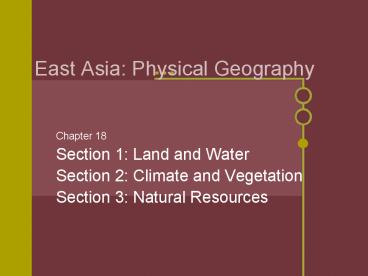East Asia: Physical Geography - PowerPoint PPT Presentation
1 / 11
Title:
East Asia: Physical Geography
Description:
East Asia: Physical Geography Chapter 18 Section 1: Land and Water Section 2: Climate and Vegetation Section 3: Natural Resources Section 1: Land and Water Landforms ... – PowerPoint PPT presentation
Number of Views:251
Avg rating:3.0/5.0
Title: East Asia: Physical Geography
1
East Asia Physical Geography
- Chapter 18
- Section 1 Land and Water
- Section 2 Climate and Vegetation
- Section 3 Natural Resources
2
Section 1 Land and Water
- Landforms in China
- Himalayas
- Highest mountain range in the world. They run
along the border of China and Nepal. - Mt. Everest one of the highest mountains in the
world. - Located in the Himalayas
- Plateau of Tibet
- A large highland area that lies north of the
Himalayas.
3
Section 1 Land and Water
- Landforms that make up East Asia.
- China takes up most of East Asias land.
- High mountains and plateaus make up most of
China. - Plains
- China and Mongolia have wide plains while Japan,
Taiwan, and the Koreas have narrow plains. - Japan is an island country in the western Pacific
Ocean. - Is an archipelago group of islands
- Has 4 main islands and more than 3,000 smaller
ones. - Nearly 80 is covered in mountains.
- Mt. Fuji is a large mountain in Japan that is a
volcano.
4
Section 1 Land and Water
- Major rivers in China
- Chang River
- Deep enough for cargo ships to sail on.
- The Three Gorges Dam is built across it to
produce more hydroelectric power and control
flooding. - Huang River
- runs through the North China Plain
- Named for the brownish-yellow soil called loess
(very fertile) that it carries and deposits on
the North China Plain. - More than 100 million people live along its banks
because it is one of the best farming areas in
China. - Floods during monsoons
- Dams are built to help control the flooding
- Both rivers begin in Tibet and flow east.
5
Section 2 Climate and Vegetation
- East Asias climate is often described as varied.
- 7 different climate regions cover East Asia.
- 5 major climate regions
- Semiarid, arid, humid subtropical, humid
continental, and highlands. - East Asias climate is influenced by
- Monsoons a wind that changes directions with the
change of seasons.
6
Section 2 Climate and Vegetation
- Climate affects what plants grow in East Asia.
- Bamboo is a plant grown in southern China and
Japan. - Is reliable because of its ability to stand
seasonal differences in temperatures and
rainfall. It can also survive dry spells.
7
Section 2 Climate and Vegetation
- Climate also affects the diet in East Asia.
- Rice grows best in warm weather.
- In Southern China rice is grown and eaten.
- Wheat grows best in cool weather.
- In Northern China people eat more things made
from wheat, such as noodles.
8
Section 3 Natural Resources
- Chinas Natural Resources
- Many mineral resources
- Coal, copper, tin, iron, and oil
- One of the largest coal suppliers in the world.
- Hydroelectric power (water)
- The Three Gorges Dam
- Located on the Chang River
- Built to produce more hydroelectric power
- Control flooding
- Aquaculture
- farming of fish, shellfish, and seaweed.
9
Section 3 Natural Resources
- Using the Land
- Little Farmland
- Many mountains and plateaus
- East Asians farm every bit of land to feed its
population. - Farmers
- cut terraces a flat area in a hillside that
allows more space to grow crops. - use double cropping growing two or more crops on
the same land, in the same season, and at the
same time.
10
Section 3 Natural Resources
- The Koreas
- North Korea
- developing country
- Industry is not strong weak economy
- Lacks modern technology
- Has mineral resources coal and iron
- South Korea
- Developed country
- Industry is strong strong economy
- Advanced in modern technology
- Lacks mineral resources coal and iron
- Imports the materials it needs to keep industry
running
11
Section 3 Natural Resources
- Japan
- Developed country
- Strong modern industry that produces many
manufactured goods - Lacks natural resources
- Imports a huge amount of minerals
- Rich economy































